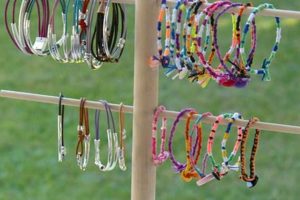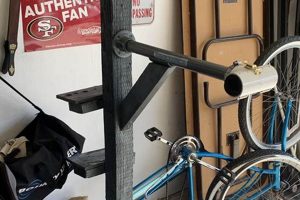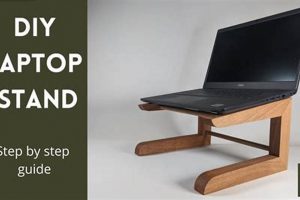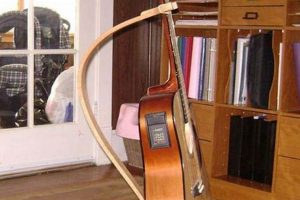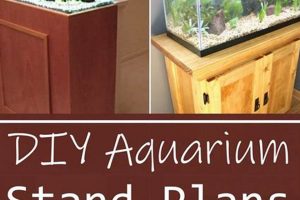A self-constructed support structure designed to hold a background for photography, videography, or event dcor. These custom-built systems offer an alternative to commercially manufactured units, often utilizing readily available materials and basic construction techniques. For example, individuals might create a structure using PVC pipes and weighted bases to display fabric backdrops.
The creation of personalized background supports presents several advantages, including cost-effectiveness and adaptability. Compared to purchasing pre-made options, building a frame from scratch can significantly reduce expenses. Furthermore, such projects allow for customization in terms of size, material, and design, accommodating specific spatial limitations or aesthetic preferences. Historically, resourceful individuals have employed similar methods to craft bespoke display solutions for various applications, demonstrating a long-standing desire for tailored, budget-friendly alternatives.
This article explores the various methods, materials, and considerations involved in the fabrication of these custom supports. Subsequent sections will detail different construction approaches, material selection criteria, and essential safety precautions.
Constructing a Stable and Versatile Support Structure
The following are considerations for building a dependable and adaptable support system for backgrounds.
Tip 1: Material Selection is Crucial. Opt for durable materials appropriate for the intended use. PVC pipe offers a cost-effective and lightweight solution for smaller backdrops. Metal pipes, such as steel or aluminum, provide increased strength and stability for larger or heavier backdrops. Consider the weight-bearing capacity of chosen materials.
Tip 2: Prioritize a Secure Base. The base forms the foundation of stability. Weighted bases, such as sandbags or concrete-filled containers, are essential to prevent tipping, especially when using heavier backdrops or working outdoors. Ensure the base is adequately sized and weighted to counterbalance the weight of the backdrop and frame.
Tip 3: Emphasize Stability at Connection Points. Securely connect all frame components. Use appropriate fittings, such as PVC cement for PVC pipes or metal connectors with bolts for metal frames. Regularly inspect connection points for any signs of loosening or wear.
Tip 4: Incorporate Adjustable Height Mechanisms. Design the structure to allow for adjustable height to accommodate various backdrop sizes and shooting angles. This can be achieved using telescoping poles or adjustable clamps.
Tip 5: Facilitate Backdrop Attachment. Implement a system for easily attaching and removing backdrops. Options include using clamps, clips, or a sewn-in rod pocket along the top edge of the backdrop material.
Tip 6: Ensure Portability and Storage Considerations. Design the structure for ease of disassembly and transportation, especially if it will be used in different locations. Consider using modular components that can be quickly assembled and disassembled. Furthermore, storage of the pieces should be considered to ensure the protection of each piece.
Tip 7: Assess Environmental Factors. If used outdoors, ensure the support frame can withstand wind. Anchoring the structure to the ground with stakes or ropes can significantly improve stability in windy conditions. The backdrop itself can act as a sail; thus, this consideration becomes paramount.
By carefully considering these aspects, a robust and adaptable frame can be created, ensuring that it will properly hold and display the backdrop safely and effectively.
The following section will address specific design plans that incorporate these tips and guidelines.
1. Stability
The concept of stability is fundamental to the successful construction and utilization of a self-assembled background support. Without adequate stability, the entire structure is compromised, potentially leading to equipment damage, safety hazards, and unsatisfactory results.
- Base Weight and Distribution
The weight and distribution of the base directly impact the structure’s ability to resist tipping. A wider base and heavier materials increase stability. For instance, a frame with a narrow base and lightweight PVC tubing is prone to toppling compared to one with a broad base filled with sandbags or concrete. Improper weight distribution can exacerbate instability, particularly with uneven loads or windy conditions.
- Material Rigidity and Strength
The rigidity and tensile strength of the materials used determine the frame’s resistance to bending and breaking under load. Materials like steel offer superior stability compared to more flexible options like thin-walled PVC. Consider a scenario where a heavy fabric backdrop is hung on a frame constructed from flimsy materials; the structure may sag or collapse, compromising the entire setup. Appropriate material selection is crucial.
- Joint Integrity and Secure Connections
The strength and security of the connections between structural components are critical. Loose or poorly secured joints introduce weak points, increasing the risk of instability. For example, PVC pipes that are not properly cemented or metal frames with loosely bolted connections can fail under stress. Regular inspection and maintenance of joints are imperative to ensure structural integrity and overall stability.
- Environmental Factors and External Forces
External elements, such as wind, uneven ground, or accidental impacts, exert forces that can undermine stability. A backdrop stand positioned outdoors is susceptible to wind gusts that can easily topple an inadequately secured structure. Similarly, placing a stand on an uneven surface compromises its balance. Addressing these environmental factors with appropriate countermeasures, such as anchoring or leveling the base, is crucial for maintaining stability.
These facets collectively highlight the critical importance of stability in the design and construction. A well-engineered system that addresses these factors ensures both safety and optimal performance, allowing for the secure and effective display of backdrops in various settings and conditions.
2. Portability
The characteristic of portability in a self-constructed background support is often a determining factor in its design and material selection. The need to transport the support structure frequently dictates the employment of lightweight materials and modular construction techniques. For instance, a photographer who regularly shoots on location will likely prioritize a design that can be quickly disassembled, easily carried, and efficiently reassembled at the destination. Consequently, materials like PVC pipe or lightweight aluminum tubing become attractive options due to their low weight and ease of handling.
Furthermore, portability influences the type of connectors and fasteners used. Complex or cumbersome connection mechanisms can hinder quick assembly and disassembly, thereby negating the benefits of a lightweight design. Therefore, systems employing quick-release clamps, snap-fit connectors, or similar user-friendly mechanisms are favored for portable background supports. Consider a scenario where a videographer needs to set up a background quickly at a remote location; a support structure with simple, intuitive connections will significantly reduce setup time and logistical challenges.
Ultimately, the degree of portability required directly shapes the entire construction strategy. Compromises between stability and weight may be necessary, and careful consideration must be given to the trade-offs between ease of transport and structural integrity. The final design represents a balance between these competing factors, tailored to the specific needs and operational environment of the user. While a highly portable structure may sacrifice some robustness, it provides unparalleled convenience for those who require frequent relocation.
3. Adjustability
In the context of self-constructed background supports, adjustability represents a critical design element, directly impacting the system’s versatility and utility. The ability to modify the height, width, or configuration of the frame enables adaptation to diverse backdrop sizes, shooting requirements, and spatial constraints. Without adjustability, a support is limited to a fixed set of parameters, potentially rendering it unsuitable for various applications. For instance, a photographer shooting both portrait and full-body shots requires height adjustability, while varying backdrop widths necessitate a system capable of width modification. The absence of such features significantly restricts the system’s adaptability.
Implementations of adjustability within a self-constructed system can take many forms. Telescoping poles allow for vertical height alteration, while modular components facilitate width expansion or contraction. Clamps and locking mechanisms enable secure fixation at desired positions. A rudimentary system could utilize simple interlocking sections, whereas more sophisticated designs incorporate geared cranks or pneumatic cylinders for fine-tuned adjustments. The choice of mechanism depends on the precision, load-bearing capacity, and ease of operation required. An event planner utilizing a support for trade show displays, for example, might prioritize a system that offers quick and effortless adjustability to accommodate varying booth sizes and banner dimensions.
Adjustability, therefore, is not merely an added feature but a core functional requirement that enhances the overall value and applicability of a self-constructed background support. It provides the flexibility to adapt to changing needs and ensures a greater return on investment by extending the system’s useful life. The consideration and proper execution of adjustability features are paramount in achieving a truly versatile and effective support solution.
4. Cost-Effectiveness
The financial aspect of constructing a background support system is a primary motivator for many individuals choosing a do-it-yourself approach. This method provides a means of achieving a functional solution while mitigating the expenses associated with commercially manufactured alternatives. The following facets explore the specific avenues through which cost savings are realized.
- Material Sourcing and Procurement
One significant avenue for cost reduction lies in the ability to source materials independently. Utilizing readily available items from local hardware stores, recycling centers, or even repurposed materials from previous projects allows for substantial savings compared to purchasing a complete, pre-fabricated unit. For example, PVC pipes, commonly used for plumbing, can be economically acquired and assembled into a functional frame. Repurposing old curtain rods or metal tubing further reduces material expenditures.
- Labor Investment vs. Monetary Outlay
The DIY approach necessitates an investment of personal time and effort, effectively trading labor for monetary savings. The time spent designing, constructing, and refining the structure represents a substitute for the cost of professional manufacturing and assembly. Individuals with basic construction skills can leverage this trade-off to minimize expenses, effectively reducing the overall cost of the background support system. This is particularly advantageous for those with limited budgets but ample time resources.
- Customization Tailored to Specific Needs
Commercially available backdrop stands often incorporate features that may not be necessary for a user’s specific application. This can lead to overspending on functionalities that are ultimately unused. A DIY approach allows for the creation of a system tailored precisely to individual needs, eliminating extraneous features and associated costs. For instance, a photographer requiring a simple, lightweight frame for headshots can construct a basic structure, avoiding the expense of a heavy-duty, multi-functional stand.
- Repair and Modification Flexibility
Self-constructed systems offer the advantage of easy repair and modification. When damage occurs or functional adjustments are required, individuals can readily replace components or modify the design without incurring significant costs. This contrasts with commercially produced stands, where repairs may necessitate specialized parts or professional services, leading to increased expenses. The ability to adapt and maintain the structure independently contributes to its long-term cost-effectiveness.
In conclusion, the cost-effectiveness of a DIY backdrop support stems from strategic material sourcing, a trade-off of labor for monetary investment, customized design, and flexible maintenance. By capitalizing on these factors, individuals can achieve a functional and suitable background support solution at a fraction of the cost associated with purchasing a commercially available product.
5. Material Durability
Material durability exerts a considerable influence on the longevity, safety, and overall value of a self-constructed background support system. The selection of materials resistant to wear, tear, and environmental degradation directly impacts the structure’s ability to withstand prolonged use and maintain its structural integrity. The cause-and-effect relationship is clear: selection of inferior materials results in premature failure, while the choice of robust materials ensures extended performance. For instance, a frame constructed from thin-walled PVC tubing will likely succumb to bending or breakage under stress, particularly when supporting heavy backdrops or exposed to temperature fluctuations. Conversely, a support built from steel or thick-walled aluminum provides significantly greater resistance to deformation and damage, leading to a more durable and reliable structure.
The importance of material durability extends beyond mere longevity. It directly impacts the safety of the setup, minimizing the risk of collapse and potential injury. A failure in a backdrop stand can result in damage to equipment, disruption of events, or even physical harm to individuals nearby. For example, an improperly constructed support that collapses during a photoshoot poses a significant safety hazard to the photographer and subject. Furthermore, material durability influences the long-term cost-effectiveness of the project. While initially cheaper materials may reduce upfront expenses, the need for frequent repairs or replacements ultimately negates these savings, resulting in higher overall costs. This is exemplified by a scenario where a wooden frame, susceptible to rot and insect infestation, requires constant maintenance and eventual replacement, surpassing the cost of a more durable metal alternative.
In summary, material durability is a cornerstone of a successful self-constructed background support system. It contributes directly to the structure’s lifespan, ensures the safety of its users, and optimizes its long-term cost-effectiveness. While challenges may exist in balancing durability with factors like portability and cost, prioritizing material quality remains essential for creating a reliable and valuable asset. The understanding of this principle allows for informed decision-making during the construction process, resulting in a backdrop stand capable of withstanding the rigors of repeated use and environmental exposure.
Frequently Asked Questions
The following addresses common inquiries regarding the construction and utilization of self-made background support structures.
Question 1: What constitutes a safe weight limit for a self-constructed backdrop support?
The maximum safe weight limit depends entirely on the materials used, the design of the structure, and the integrity of its connections. There is no universal answer. Thoroughly calculate the load-bearing capacity of all components and apply a significant safety factor. Overloading the structure poses a risk of collapse and potential injury.
Question 2: Which material is most suitable for a portable background support?
Lightweight aluminum tubing or PVC pipe are often favored for portable structures. Aluminum offers a higher strength-to-weight ratio than PVC, but PVC is generally more cost-effective. Consider the trade-offs between weight, strength, and cost when selecting the appropriate material.
Question 3: How can wind resistance be improved for outdoor usage?
Wind resistance can be enhanced by using a wider base, weighting the base with sandbags or concrete, and anchoring the structure to the ground with stakes or ropes. Reducing the surface area of the backdrop exposed to the wind also minimizes the risk of tipping.
Question 4: Is it necessary to use specialized tools for construction?
The required tools depend on the chosen design and materials. Basic tools such as a saw, measuring tape, drill, and appropriate fasteners are typically sufficient for simple PVC or wooden structures. Metal frames may necessitate welding equipment or specialized metal-cutting tools.
Question 5: How should the backdrop be attached to the support structure?
Various methods exist, including clamps, clips, sewn-in rod pockets, and hook-and-loop fasteners. The optimal method depends on the type of backdrop material and the desired level of security and ease of attachment. Secure attachment is crucial to prevent slippage or detachment of the backdrop.
Question 6: How can a perfectly vertical support be assured?
Utilize a level during construction to ensure that all vertical components are plumb. Adjustable feet or shims can be used to compensate for uneven ground surfaces. Regular verification with a level is recommended to maintain vertical alignment.
Adherence to fundamental engineering principles and careful material selection ensures that DIY stands function properly and safely.
The following portion of this article provides step-by-step guidelines for the creation of such project.
DIY Backdrop Stand
This article has explored the multifaceted nature of the “diy backdrop stand,” examining its design elements, material considerations, and practical applications. Key aspects, including stability, portability, adjustability, cost-effectiveness, and material durability, have been addressed to provide a comprehensive understanding of the factors influencing successful construction. The preceding frequently asked questions section served to clarify common concerns and offer practical guidance for prospective builders.
The information presented herein is intended to equip individuals with the knowledge necessary to make informed decisions regarding the design and construction of a customized background support system. Implementing these principles fosters creative opportunities while upholding safety standards. Further research and adherence to sound engineering practices are encouraged to ensure optimal results.



